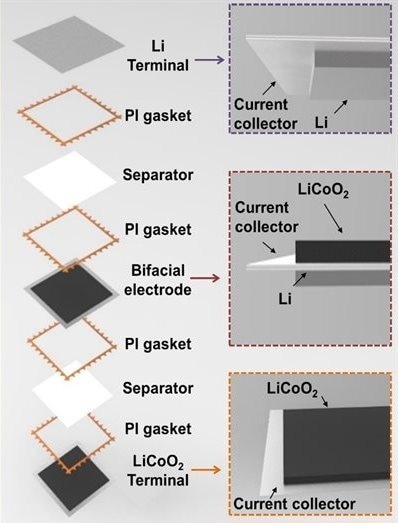The capability of batteries to power microdevices, microrobots, and implanted medical devices has been constrained by the long-standing technological challenge of translating the electrochemical performance of large-format batteries to microscale power sources.
 Schematic of microbattery design. Image Credit: University of Illinois Urbana-Champaign
Schematic of microbattery design. Image Credit: University of Illinois Urbana-Champaign
A high-voltage microbattery (>9 V) with unmatched energy and power density has been developed by researchers at the University of Illinois Urbana-Champaign.
The study published in the journal Cell Reports Physical Science was authored by Material Science and Engineering Professor Paul Braun (Grainger Distinguished Chair in Engineering, Materials Research Laboratory Director), Dr. Sungbong Kim (Postdoc, MatSE, currently Assistant Professor at Korea Military Academy, co-first author), and Arghya Patra (Graduate Student, MatSE, MRL, co-first author).
The researchers demonstrated hermetically sealed (firmly closed to avoid exposure to ambient air), long-lasting, compact lithium batteries with an extremely low package mass fraction in single-, double-, and triple-stacked configurations with extraordinary operating voltages, power densities, and energy densities.
We need powerful tiny batteries to unlock the full potential of microscale devices, by improving the electrode architectures and coming up with innovative battery designs.
Paul Braun, Professor, Material Science and Engineering, University of Illinois Urbana-Champaign
The challenge is that as batteries get smaller, the packaging takes over the volume and mass of the battery while the electrode area reduces. As a result, the battery’s energy and power are drastically reduced.
The group created revolutionary packaging technology that utilized the positive and negative terminal current collectors as part of the packaging itself (rather than a separate entity) in their unique design of powerful microbatteries.
This enabled the batteries to have a small volume (≤0.165 cm3) and a low package mass fraction (10.2%). Furthermore, scientists vertically stacked the electrode cells in series (such that the voltage of each cell adds), enabling the battery’s high operating voltage.
Another approach to enhance these microbatteries is to use very dense electrodes that provide energy density. Polymers and carbon additives occupy over 40% of the volume of normal electrodes (not active materials). Braun’s group has created electrodes that are entirely dense and free of polymer and carbon additives using an intermediate temperature direct electrodeposition technique.
These dense electrodes have a higher volumetric energy density than commercial electrodes. The dense electroplated DirectPlateTM LiCoO2 electrodes used in this research were developed by Xerion Advanced Battery Corporation (XABC, Dayton, Ohio), a company that developed out of Braun’s research.
To date, electrode architectures and cell designs at the micro-nano scale have been limited to power dense designs that came at the cost of porosity and volumetric energy density. Our work has been successful to create a microscale energy source that exhibits both high power density and volumetric energy density.
Arghya Patra, Study Co-First Author and Graduate Student, University of Illinois Urbana-Champaign
Powering insect-sized microrobots to gather vital information during natural disasters, in hazardous environments, and in search and rescue missions, where direct human access is difficult, is a major application field for these microbatteries.
The high voltage is important for reducing the electronic payload that a microrobot needs to carry. 9 V can directly power motors and reduce the energy loss associated with boosting the voltage to the hundreds or thousands of volts needed from some actuators. This means that these batteries enable system level improvements beyond their energy density enhancement so that the small robots can travel farther or send more critical information to human operators.
James Pikul, Study Co-Author and Assistant Professor, Department of Mechanical Engineering and Applied Mechanics, University of Pennsylvania
“Our work bridges the knowledge gap at the intersection of materials chemistry, unique materials manufacturing requirements for energy dense planar microbattery configurations, and applied nano-microelectronics that require a high-voltage, on-board type power source to drive microactuators and micromotors,” added Kim.
“Our current microbattery design is well-suited for high-energy, high-power, high-voltage, single-discharge applications. The next step is to translate the design to all solid-state microbattery platforms, batteries which would inherently be safer and more energy dense than liquid-cell counterparts,” added Braun, a pioneer in the field of battery miniaturization.
Dr. James H. Pikul (Assistant Professor, Department of Mechanical Engineering and Applied Mechanics, University of Pennsylvania), Dr. John B. Cook (XABC), Dr. Ryan Kohlmeyer (XABC), Dr. Beniamin Zahiri (Research Assistant Professor, MRL, UIUC) and Dr. Pengcheng Sun (Research Scientist, MRL, UIUC) also contributed to the research.
Journal Reference:
Kim, S., et al. (2022) Serially integrated high-voltage and high power miniature batteries. Cell Reports Physical Science. doi.org/10.1016/j.xcrp.2022.101205.